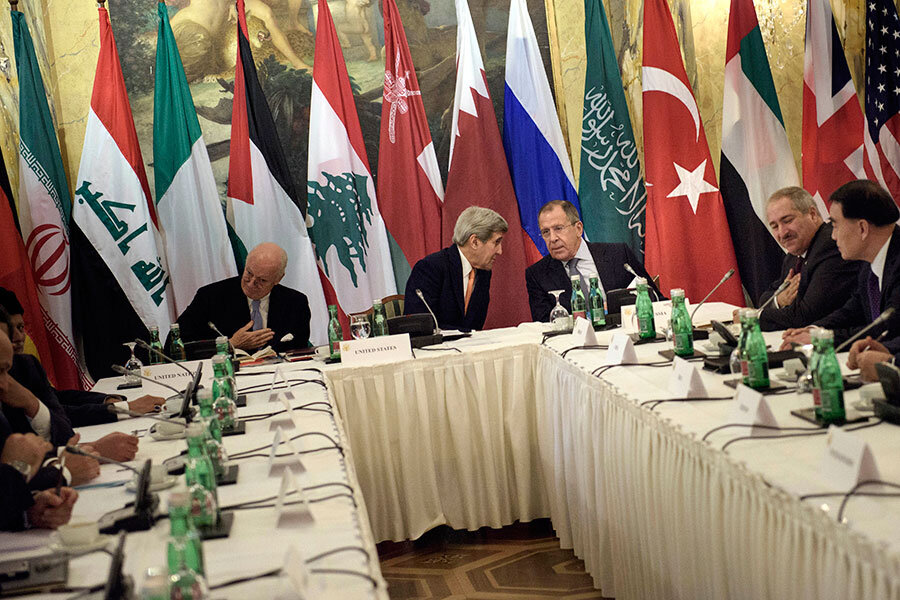What's behind US Special Forces in Syria? A new realism
Loading...
| Washington
President Obama’s foreign-policy realism is on full display this week on two fronts related to Syria.
First, the United States sat down Friday with Iran at international talks on Syria – despite years of opposing any diplomatic role for Tehran in efforts to end the Syrian civil war.
Second, the White House announced Friday that the US will send just under 50 special operations forces to northern Syria – a move that reverses the president’s pledge from more than a year ago not to put boots on the ground in the fight.
In both cases, the developments reflect recognition that conditions on the ground have changed and that on both the military and diplomatic fronts, new approaches are required.
The special operations forces will be deployed to advise and work alongside Kurdish and other opposition forces that have secured and now hold territory once controlled by the self-proclaimed Islamic State (IS or ISIS).
The deployed forces “will be an important force multiplier,” said White House spokesman Josh Earnest Friday, as he argued that the deployment is not so much a change of strategy as a shift because it involved “building the capacity of local forces on the ground.”
The announcement does reflect a move away from the failed US effort to train and equip large numbers of opposition fighters and is a reemphasis of parts of the anti-IS strategy that Defense Department officials consider to have shown more promise.
In addition to the troop deployment, the administration will also be sending additional fighter jets to Turkey to ramp up airstrikes on IS positions.
Accepting Iran
The diplomatic shift to accept Iran at the Syria conference table after years of refusal suggests acceptance of the argument that Syria’s civil war, now in its fifth year, cannot be resolved without Iranian participation.
With Iran’s involvement in Syria deepening in recent months, the Obama administration appears to have concluded that the Iranian footprint in Syria’s war has become too large to keep the Iranians outside the diplomatic tent.
But that does not mean the US expects Iran to play a positive role in the international talks on Syria that were held Friday in Vienna, or that the US expects the Iranians to suddenly move away from supporting Syrian President Bashar al-Assad.
Instead, the US reversal on Iran’s participation reflects a willingness to test Iran’s diplomatic stance – particularly since the successful conclusion of the Iran nuclear talks in July – as well as a desire to try new options for bringing Syria’s devastating war to a close.
At the last international talks on Syria in January 2014, the US kept the door closed to Tehran, and after that, it repeatedly insisted that Iran had no role to play. Mr. Obama’s shift on Iran was divulged earlier this week when the State Department revealed Iran would be invited to the Vienna talks.
“It’s important for us that key partners are in these discussions,” State Department spokesman John Kirby told reporters Tuesday. “[The Iranians] could be a key partner,” he added, “but they are not now.”
On Thursday, another State Department official told members of Congress that the US will be gauging the Iranian and Russian positions on two key questions in Vienna: whether they are open to seeing Mr. Assad leave power in a political transition ending the war, and to what extent they are committed to striking and defeating IS.
Secretary of State John Kerry aims to weigh “the extent to which [the Russians and Iranians] are prepared to work broadly with the international community to convince Mr. Assad that during a political transition process, he will have to go,” State Department counselor Thomas Shannon told the Senate Foreign Relations Committee. Mr. Shannon is the administration’s nominee to become undersecretary for political affairs, the department’s third-ranking post.
Misgivings
Yet while inclusion of Iran in the Syria talks may represent a nod to realism, not everyone agrees it’s a good idea.
“With the Iranians at the table, we now have the three parties least interested in a genuine transition in Syria as opposed to simply smashing rebel groups – Assad’s forces, the Russians, and the Iranians, all feeling they are dealing from a position of strength,” says Wayne White, a former State Department intelligence analyst on the Middle East who is now an adjunct scholar at the Middle East Institute in Washington. “It’s not positive for the negotiations.”
Accepting Iran at the table disregards the trouble that Iran has caused the US in the region for decades, particularly next door in Iraq, Mr. White says.
“Iran has not played a positive role in the Syria-Iraq region for years, so I don’t know why we should go for this idea that they might now be amenable to behaving better and coming down on the side of a political transition encompassing all Syrians,” he says.
“We’re forgetting that [Iran] backed the incredibly ruthless and divisive Maliki regime in Iraq that arguably gave us the ISIS problem, and sent in the Shia militias that have committed sectarian cleansing in Iraq,” he adds. “In Syria, they are dealing with proxies that have had no compunction about committing atrocities, particularly against Sunni-Arab Syrians.”
Asked if accepting Iran at the Syria talks isn’t a sign of diplomatic realism, White says, “I don’t think we have to accept Iran at the table simply because they have forces on the ground involved in the fight. Russia is already there representing the pro-Assad position,” he adds, “so why do we need to give it another seat at the table?”









